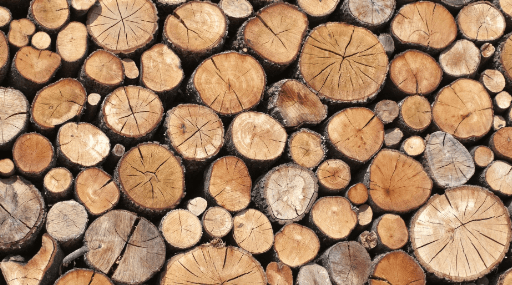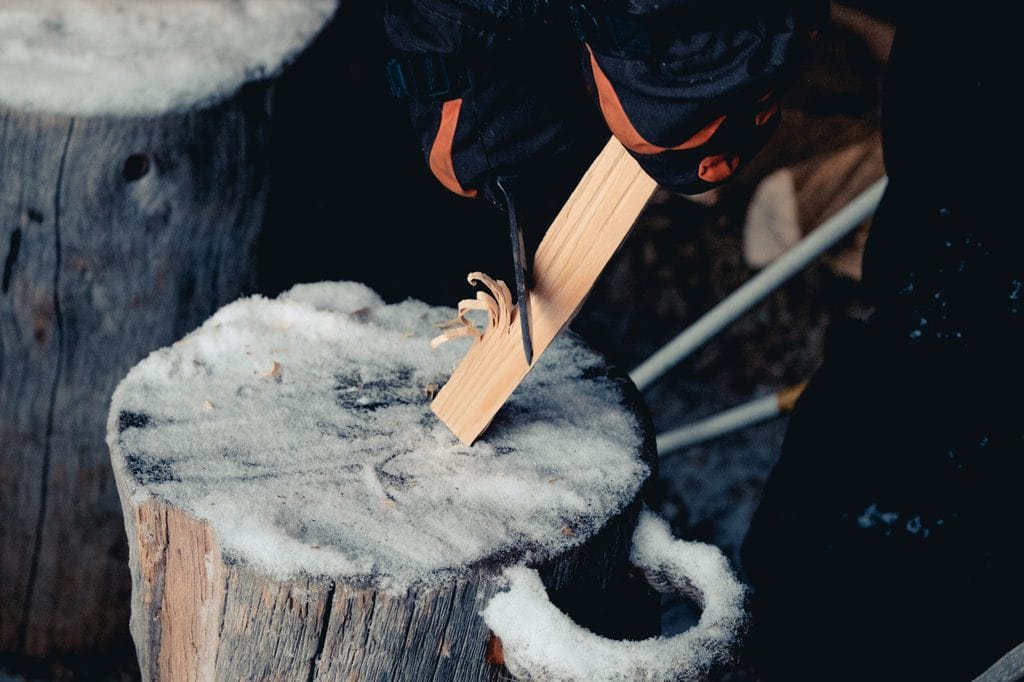
Whittling is a relaxing, creative hobby for crafters and woodworking enthusiasts alike. Best of all, it’s relatively inexpensive—all you need is a piece of wood and the right whittling knife.
So, are you looking for the best knife to start (or grow) your collection? You’ve come to the right place! We will review 5 of the best whittling knives on the market today, and include some helpful tips, tricks, and FAQs every whittler needs to know.
The 5 Best Whittling Knives
Whether you’re an expert whittler or just getting started, the right tools will make a huge difference. Fortunately, whittling knives are affordable and super versatile — a great knife will help you tackle any project.
To help you make your choice, here’s our honest review of the 5 best whittling knives on the market in 2021.
1. Best Overall Knife: Morakniv 120 Wood Carving Knife

Want an affordable whittling knife that will last for years? You can’t go wrong with the Morakniv 120.
This little whittling knife is lightweight, rust-resistant, and surprisingly durable for the price. It has a 2.4-inch laminated steel blade and an oiled birchwood handle. At 4 inches long and only a few ounces in weight, the knife is easy to carry with you in a tool kit or craft box.
What makes the Morakniv knife stand out from other options on this list is the high carbon steel core in the blade. This gives the blade its long-term durability without adding too much weight. The core is surrounded by softer, corrosion-resistant steel to keep it light and usable.
To top it off, this knife comes at a super affordable price that makes it accessible to any whittler. Whether you’re adding it to your collection or using it as your primary whittling knife, you’ll get tons of value out of the Morakniv 120.
Things We Like:
- High carbon core makes it strong and durable
- Rust-resistant steel alloy coating
- Affordable price for the quality
Things We Don’t:
- Slightly pricier than some other options
- Plain birch handle with no grip
2. Best Budget Option: BeaverCraft Sloyd Knife C4s

For woodworkers on a budget, this BeaverCraft knife has changed the game. It’s compact, comfortable to hold, and comes at an awesome price for the quality.
The BeaverCraft Sloyd Knife has a 3.14-inch blade with a long cutting edge, perfect for making deep cuts in a larger piece of wood. The solid oakwood handle is ergonomically shaped to provide a comfortable grip. It has also been treated with natural linseed oil to prevent rot and extend the overall lifespan of the knife.
The blade of this knife is made with high-carbon steel. That makes it durable and long-lasting, but it is also slightly heavier than a steel alloy knife. It also needs to be cleaned and sharpened regularly to prevent corrosion.
To top it off, the BeaverCraft Sloyd Knife comes with a genuine leather sheath that will look great in your craft kit. It makes a wonderful starter knife or gift for anyone interested in whittling.
Things We Like:
- Sturdy, solid oak handle with grip-friendly design
- Long blade for a variety of wood carving projects
- Stitched leather sheath with belt loop attachment
Things We Don’t:
- High carbon steel blade can succumb to rust
- Heavier than other options—not ideal for a beginner
3. Best Knife For Beginners: BeaverCraft Wood Carving Detail Knife C15

If you’re interested in learning how to whittle, this is an excellent knife to start with. The BeaverCraft Detail Knife has a short, lightweight blade and a comfortable handle that’s perfect for beginners of all ages.
At 4.5 inches long, this knife is easy to hold and maneuver. The blade is only 1.37 inches long and can make small, detailed cuts with plenty of room for error. It’s a great way for new whittlers to learn how to control a knife and get used to the feeling of whittling.
The blade of this knife is made from high carbon steel, which will last for years with the proper care (it should be cleaned and sharpened regularly). A lightweight ash handle provides a comfortable grip for hands of any size — in other words, this is an excellent knife to teach a child how to whittle.
Things We Like:
- The short blade allows for small, detailed carving
- Comfortable handle prevents hand cramping
- Great for kids or grownups
Things We Don’t:
- Not great for broad, long cuts
- Doesn’t come with a sheath
4. Best Folding Knife: Opinel No.08 Folding Pocket Knife

Looking for a knife you can safely put in your pocket and take with you? Check out the Opinel No. 8. This little knife is great for casual whittling, carving, or anything else you need.
This little knife has a 3.28-inch carbon steel blade—longer than any other option on this list. It can be used to make broad, flat cuts, or for detailed whittling with the curved tip. The blade folds up into the durable beechwood frame for easy carrying and storage.
Because the Opinel Pocket Knife is made from hard carbon steel, it is slightly heavier than some of the other knives on this list. However, it is also extremely durable and will last for years with minimal maintenance and sharpening. The handle is ergonomic and comfortable to hold, making this your go-to pocket knife for any craft or chore.
Things We Like:
- Compact, foldable design
- The long blade can tackle any whittling or carving project
- Comfortable to hold and use for a long time
Things We Don’t:
- Heavier than other portable knives
- Not great for a beginner
5. Best Multi-Blade Knife: Old Timer 24OT Splinter Carvin’ Knife

Last (but not least) on our list of the best whittling knives is the Old Timer 24OT, an awesome multi-blade knife that can take on any task.
This knife has a 4.5-inch handle with a variety of foldable tools. The longest blade is 1.5 inches, perfect for making detailed cuts in your whittling projects. It also has a straight gouge, hook blade, V-score, gouge score, and a chisel knife—handy tools that come with every whittling kit.
A nail-pulling tool in the knife helps you to remove old nails and screws from wood. This is a great feature for whittlers who like to work with reclaimed wood or dismantle old projects. Every blade and tool in this knife is made with tough, high carbon steel for extra durability and precision.
At a crazy affordable price for the value, this Old Timer knife would make a wonderful addition to any craft or tool kit.
Things We Like:
- Multiple blades and tools for detailed whittling
- Comes with a nail-pulling tool for working with reclaimed wood
- The sturdy grip makes it comfortable to hold
Things We Don’t:
- The longest blade is 1.5 inches—not great for broad cuts
- Heavy to carry in your pocket
Tips To Find The Best Whittling Knife

Before you start shopping for the best whittling knife, you need to know what you’re looking for. Whittling knives are simple, affordable tools. But there are plenty of factors that can influence your decision.
Here are a few tips to help you find the best whittling knife for your needs and preferences.
The Blade

The first thing you’re going to look at when shopping for a new whittling knife is the blade. The blade is the most relevant feature of your knife and will determine what kinds of cuts you can make and how long the knife will last.
There are a few factors that go into choosing the right blade, including:
1. Blade Length
The length of the blade determines what kinds of cuts it can make. Longer blades (over 3 inches) are great for making broad cuts in larger pieces of wood. Short blades (under 2 inches) are better for small details.
While a skilled whittler can work with any knife, in general, shorter blades are best for beginners. They are easy to handle, and there is no risk of ruining your artwork with a broad cut.
2. Steel Type
Next, consider the type of steel in your knife blade. Most pocket knives and whittling knives have a high carbon steel blade. This material is durable, tough, and easy to re-sharpen.
However, the one downside to carbon steel is that it can easily rust. Stainless steel, or an alloy steel coating, will make your knife corrosion-resistant and extend its lifespan.
3. Blade Shape
Small knife blades come in a variety of shapes for different purposes. This is especially true of whittling knives.
One area of the blade you will want to pay attention to is the belly. A knife’s belly is the curved part of the blade, just below the tip. A knife with a smaller belly is easier to handle and perfect for a beginner. Once your skills improve, you will be able to make broad cuts with a larger knife.
Some specialty whittling knives come in unique shapes, such as a hook blade. These blade shapes make great additions to your crafting kit but should not be used as your primary whittling knife.
4. Folding Blades
As you might have noticed in our list of the best whittling knives, some have folding blades — similar to pocket knives — while others have a fixed blade and handle.
In general, fixed blades are better for small, detailed designs. These knives have large wooden handles that are comfortable to grip and easy to use for a long time. On the other hand, folding blades are convenient and portable.
If you choose a knife with a folding blade, make sure it has a locking feature. This feature will prevent the knife from closing on your fingers while you are working.
5. Multi-Blade Whittling Knives
Multi-blade knives are helpful for whittlers who want to have multiple options without investing in a full knife set. These knives usually come with 5-10 attached blades and tools.
It’s important to remember that the blades on a multi-blade knife are not always high quality. These blades are short and often flimsy. Most skilled whittlers prefer to use full sets of tools.
That said, if you are learning to whittle and want to have multiple options in your pocket, a multi-blade knife will get the job done.
The Handle

While the blade is the most important feature, a whittling knife is nothing without its handle.
The handle of your knife should be sturdy, comfortable, and easy to hold. A handle with an ergonomic grip will keep your hand steady while you are working. That means less risk of your hand cramping.
The best material is a matter of personal preference, but you have a few options: wood, plastic, and steel are the most popular.
Wood handles give the knife an authentic, rustic look. They are also comfortable to hold and can adjust to the shape of your hand over time. However, wood can also develop cracks or mold if you don’t store your knife in a safe, dry place.
Plastic handles may not look as nice, but they are mold-free and affordable. Steel is a solid option if you want your knife to last for years in outdoor conditions.
No matter what handle material you choose, make sure it is well-built. Cheap, poorly-made knives come with handles that will detach or crack as you are using them.
Wood Type

Finally, you need to consider the type of wood you are going to be working with. Different wood types have varying degrees of softness and require unique tools.
Most whittlers buy pre-cut pieces of wood to work with. Those pieces are generally made from softwoods like pine or cedar. Basswood is the most common wood type for whittling — it’s soft, easy to shape, and affordable.
If you are a beginner, you might not want to pay for pre-cut woodblocks. Practicing on any stick or piece of wood you find outside is a great way to learn. In that case, you should start with a simple, straightforward whittling knife.
As your skills develop, you can invest in specialty whittling tools and hook blades to carve details into softer woods.
FAQs
If you still have some questions about whittling and which knives to use, we have the answers to your questions here!
How Is Whittling Different from Wood Carving?
Whittling is essentially wood carving on a smaller scale. Carving requires several heavy tools and hours of hard work. Whittling is a passive activity that only requires one or two small knives.
The most significant difference is the final product. Wood carving produces statues, pillars, and other large works of art. A whittling project, on the other hand, is usually small enough to put in your pocket.
Can You Whittle with a Pocket Knife?
Yes! A pocket knife can tackle a variety of tasks, including whittling. Some pocket knives even have multiple blades and tools to help you whittle.
That said, some skilled whittlers prefer to use specialty knives. Pocket knives are not shaped and sharpened for complicated wood carving. As your skills develop, you might want to invest in a whittling knife to create intricate, detailed projects.
How Do You Sharpen a Whittling Knife?
Because whittling knife blades are so small, you can’t sharpen them with your kitchen knife sharpener. The best method is to use a sharpening stone.
Press the flat side of the blade against the sharpening stone, then push it away from you at a slight angle. The stone will sharpen the blade without damaging the knife. You can also apply pressure to the blade and rub it in a circular motion against the sharpening stone — this is a safe method that doesn’t risk cutting yourself or dropping the knife.
What’s the Best Way to Learn How to Whittle?
The best way to improve your whittling skills is to practice. Whittling is a creative hobby that people have been practicing for generations—you don’t need to pay for expensive classes or tools to get better.
There are plenty of free resources, like blogs and Youtube channels, to help you become a better whittler. You can also practice on your own to develop your talent. The more you whittle, the more your skills will improve!
Final Thoughts

Whittling is a creative, fun, and inexpensive hobby that anyone can learn. If you want to become a whittler, all you need is a piece of wood and the right knife!
Of all the whittling knives reviewed in this article, the Morakniv 120 Wood Carving Knife is our overall top pick. This knife is durable, easy to use, and will last for years. Buy it to get started on your whittling journey today!
If the Morakniv knife is outside your budget, you might want to try the BeaverCraft Sloyd C4s or the BeaverCraft C15 for beginners. The Opinel Pocket Knife and Old Timer 24OT are both great options if you want a versatile knife.
Once you choose the right whittling knife for you, all you need is a piece of wood and some time to practice. You will become a talented whittler in no time!
Looking for more? Check out our other tool reviews for the best reviews and buyers guides!

